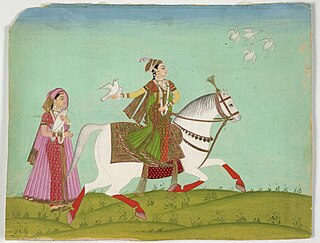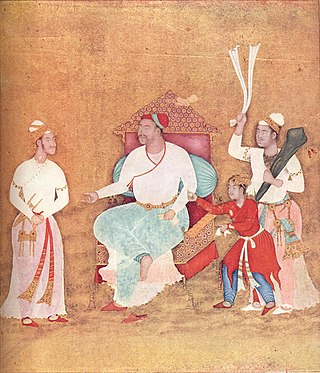The Deccan sultanates is a historiographical term referring to five late medieval to early modern Indian kingdoms on the Deccan Plateau between the Krishna River and the Vindhya Range that were created from the disintegration of the Bahmani Sultanate and ruled by Muslim dynasties: namely Ahmadnagar, Berar, Bidar, Bijapur, and Golconda. The five sultanates owed their existence to the declaration of independence of Ahmadnagar in 1490, followed by Bijapur and Berar in the same year. Golconda became independent in 1518, and Bidar in 1528.

Berar Province, also known as the Hyderabad Assigned Districts, was a province of Hyderabad. After 1853, it was administered by the British, although the Nizam retained formal sovereignty over the province. Azam Jah, the eldest son of the 7th Nizam, held the title of Mirza-Baig ("Prince") of Berar.

Burhanpur is a historical city in the Indian state of Madhya Pradesh. It is the administrative seat of Burhanpur District. It is situated on the north bank of the Tapti River and 512 kilometres (318 mi) northeast of city of Mumbai, 340 kilometres (211 mi) southwest of the state's capital city of Bhopal. The city is a Municipal Corporation.

The Sultanate of Bijapur was an early modern kingdom in the western Deccan and South India, ruled by the Adil Shahi or Adilshahi dynasty. Bijapur had been a taraf (province) of the Bahmani Sultanate prior to its independence in 1490 and before the former's political decline in the last quarter of the 15th century. It was a member of the Deccan Sultanates, the collective name of the five successor states of the Bahmani Sultanate. At its peak, the Sultanate of Bijapur was one of the most powerful states in South Asia, second to the Mughal Empire, which conquered it on 12 September 1686 under Aurangzeb.

Qutb-ud-Din Bahadur Shah, born Bahadur Khan was a sultan of the Muzaffarid dynasty who reigned over the Gujarat Sultanate, a late medieval kingdom in India from 1526 to 1535 and again from 1536 to 1537. He ascended to the throne after competing with his brothers. He expanded his kingdom and made expeditions to help neighbouring kingdoms. In 1532, Gujarat came under attack of the Mughal Emperor Humayun and fell. Bahadur Shah regained the kingdom in 1536 but he was killed by the Portuguese on board a ship when making a deal with them.

Nashik district, formerly known as Nasik district, is a district in Maharashtra, India. The city of Nashik is the administrative headquarters of the district. Nashik is well known for the production of wine. Nashik is also known as Mini Maharashtra, because the climate and soil conditions of Surgana, Peth, Igatpuri resembles with Konkan. Niphad, Sinnar, Dindori, Baglan blocks are like Western Maharashtra and Yeola, Nandgaon, Chandwad blocks are like Vidarbha Region. Nashik is the biggest city in the district while Malegaon is the second biggest city. Manmad, Igatpuri, and Sinnar are some of the big cities situated in the Nashik District. Manmad is one of the biggest railway junctions in India while the city of Malegaon is famous for its powerloom.
Ismail Adil Shah was the Sultan of Bijapur who spent most of his time extending his territory. His short-lived reign helped the dynasty establish a stronghold in the Deccan.

Khuldabad is a city and a Taluka of Aurangabad district in the Indian state of Maharashtra. It is known as the Valley of Saints, or the Abode of Eternity, because in the 14th century, several Sufi saints chose to reside here. The Bhadra Maruti Temple and Dargah of Zar Zari Zar Baksh, Shaikh Burhan ud-din Gharib Chisti and Shaikh Zain-ud-din Shirazi, along with the tomb of the Mughal emperor Aurangzeb and his trusted General Asif Jah I, the first Nizam of Hyderabad, are located in this town. It is a holy and spiritual city of Islamic saints.

The Malwa Sultanate was a late medieval kingdom in the Malwa region, covering the present day Indian states of Madhya Pradesh and south-eastern Rajasthan from 1401 to 1562. It was founded by Dilawar Khan, who following Timur's invasion and the disintegration of the Delhi Sultanate, in 1401, made Malwa an independent realm.
The Berar Sultanate, also known as the Imad Shahi Sultanate was an early modern Indian kingdom in the Deccan, ruled by the Imad Shahi dynasty. It was one of the Deccan sultanates and established in 1490 following the disintegration of the Bahmani Sultanate, and was annexed by Ahmadnagar in a 1572 invasion.

The Gujarat Sultanate or Sultanate of Guzerat was a late medieval Indian kingdom in Western India, primarily in the present-day state of Gujarat. The kingdom was established in 1394 when Muzaffar Shah I, the Governor of Gujarat, declared independence from the Tughlaq dynasty of Delhi.

Ahmad Shah I, born Ahmad Khan, was a ruler of the Muzaffarid dynasty, who reigned over the Gujarat Sultanate from 1411 until his death in 1442. He was the grandson of Sultan Muzaffar Shah, founder of the dynasty.

Sultana Chand Bibi was an Indian ruler and warrior. She acted as the Regent of Bijapur Sultanate during the minority of Ibrahim Adil Shah II in 1580-1590, and regent of Ahmednagar Sultanate during the minority of her great nephew Bahadur Shah in 1595-1600. Chand Bibi is best known for defending Ahmednagar against the Mughal forces of Emperor Akbar in 1595.
The Farooqi dynasty or the Farooq Shahi was the ruling dynasty of the Khandesh Sultanate from its inception in 1382 till its annexation by the Mughal emperor Akbar in 1601. The founder of the dynasty, Malik Ahmad participated in a rebellion against the Bahmani ruler Muhmmad Shah I in his early years. When he was compelled to flee from Deccan, he established in Thalner on the Tapti River. After receiving the grant of the fiefdoms of Thalner and Karanda from Firuz Shah Tughluq in 1370, he conquered the region around Thalner, which later became known as Khandesh. By 1382, he started ruling independently.

The Berar Subah was one of the Subahs (provinces) of the Mughal Empire, in Central India from 1596 to 1724. It bordered Golconda, Ahmandagar, Kandesh and Malwa provinces as well as the independent and tributary kingdoms to the east.

Narnala Fort or Narnala Qila Sarkar, also known as Shahnoor Fort, is a hill fortress in the Satpura Range of Vidarbh, Maharashtra, India, named after the Rajput Solanki Chaulukya Ruler, Raja Narnal Singh, also known as Narnal Singh Swami. It was renamed as "Shahnoor" by Islamic rulers but again acquired, rebuilt and got its name "Narnala" by ruler Rao Rana Narnal Singh Solanki, who migrated from Patan in Gujarat.

The Sultanate of Ahmednagar or the Nizam Shahi Sultanate was a late medieval Indian Muslim kingdom located in the northwestern Deccan, between the sultanates of Gujarat and Bijapur, ruled by the Nizam Shahi or Bahri dynasty. It was established when Malik Ahmed, the Bahmani governor of Junnar after defeating the Bahmani army led by general Jahangir Khan on 28 May 1490 declared independence and established the Nizam Shahi dynasty of the Sultanate of Ahmednagar.

Daniyal Mirza was the shahzada of the Mughal Empire who served as the Viceroy of the Deccan. He was the third son of Emperor Akbar and the half-brother of Emperor Jahangir.

Burhan Nizam Shah II was the ruler of Ahmadnagar Sultanate in the Deccan. He was the second son of Hussain Nizam Shah I and Khunza Humayun Begum.
Malik Ahmad Nizam Shah was the founder of the Nizam Shahi dynasty and the Ahmadnagar Sultanate.
















